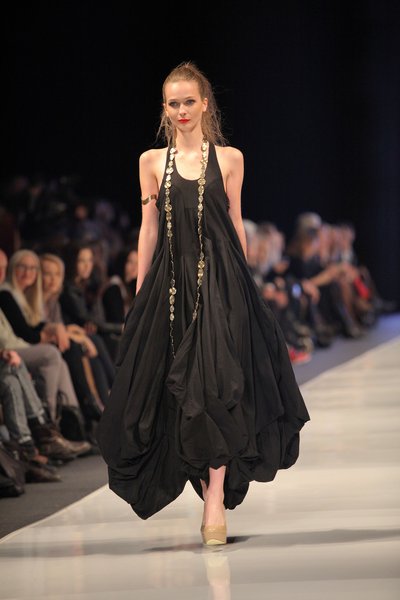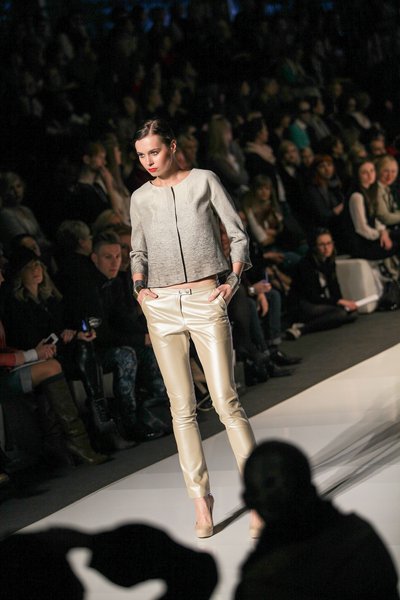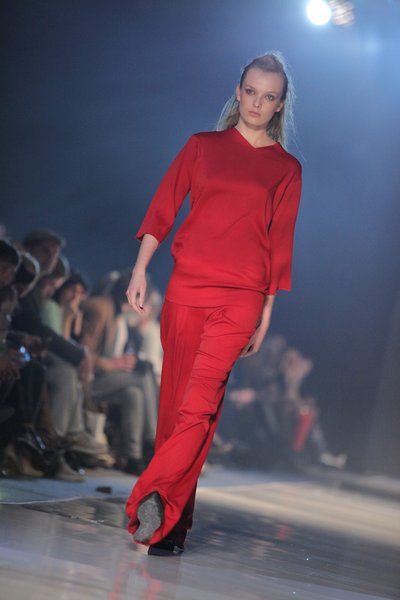Fashion Polish style
Fame, money, having your own TV programme. Hundreds of young people who dream of becoming designers see themselves posing for photographs in glossy celebrity news magazines or being presented on Paris catwalks. Such is the striking power of the myth of haute couture.
One doesn’t become John Galliano overnight, but this is something that young Poles dreaming of becoming fashion designers have yet to learn. The most audacious and motivated took part in a TV programme called Project Runway to achieve just two days of fame on an Internet gossip site. Because fashion is much more than showing off on TV.
“In London, maybe one or two graduates each year become assistants of an assistant at a major fashion house,” Professor Lou Taylor, lecturer at the Fashion Department of the University of Brighton and author of many books on fashion told me. “The majority gets stuck in companies where they work anonymously. If someone makes it, it is only after ten or so years.”
 Failures and successes
Failures and successes
Two talented girls from Poland who studied at one of the most prestigious fashion design schools, the London-based Central Saint Martins, have been through this ordeal. After graduating, they returned to Poland and opened a business in Warsaw. They proved their skills at their debut fashion show in the spring of 2010. They presented a well-made, mature collection: original but not bizarre. The show was enthusiastically received. The designers received flowers, applause and favourable reviews.
This story had a beautiful beginning but no happy ending. Although the debutants were energetic, gifted, professionally prepared and financially supported by their parents, who helped them lease a store in downtown Warsaw, their business flopped. The designs that the critics loved did not sell on the Polish market. Today, the designers don’t want to recollect this unpleasant experience. They have taken up a different career.
“Maybe we weren’t aggressive enough, maybe the market wasn’t ready for the kind of clothes we were making back then,” reflects one of them. “Sometimes, when I meet a girl wearing a dress we designed, I feel sad…”
Kaaskas company seems to have been luckier. It was launched three years ago by sisters Katarzyna and Julia Skórzyńska. The company is still young, but it has already received several prizes. The business was featured in the media and opened a shop online. Katarzyna Skórzyńska studied at the International School of Fashion & Costume Design (MSKPU) in Warsaw, in Lisbon, and at the faculty of cultural studies of the University of Warsaw. She received her Bachelor’s degree from the Department of Fashion at the Warsaw Academy of Fine Arts (ASP). An ASP lecturer, Janusz Noniewicz, suggested that she present her collection at the Polish Week in Beijing. She was awarded a prize there and her collection was displayed at the National Art Museum.
After receiving a second prize, this time from “Twój Styl” magazine for their design debut, the sisters decided to launch their own company. They presented their collections at the Who Is Next fashion fair in Paris and were successful in selling their clothes to boutiques in Riga and Berlin.
“In Paris, we saw how big the competition is in this business,” Katarzyna Skórzyńska says. “We felt like a drop in the ocean. In Poland, there are definitely fewer competitors, but still it is difficult for a young brand to break into the market. First of all, boutiques don’t buy clothes from us, as is the case in the West, but offer them for sale on a commission basis. This is a risk for us – we have to invest in clothes and we don’t know how many of them will be sold. Also, labour costs are high. Our market is still not very mature. No one cares whether an item was manufactured in Poland or in China. It’s the price that counts.”
This is the reality. According to a GfK’s market research done in 2015, Poles living in cities spend PLN 2,200 (app. EUR 500) on clothes and shoes annually. You can forget about designer clothes for this price. “It has to be cheap and not easy to crease,” Rafał Michalak confirms with a smile. He and his wife Ilona Majer run Design Studio MMC.
A graduate of the Lodz Academy of Fine Arts, Michalak has 20 years of experience in the Polish fashion market to his credit. MMC was launched in pioneering times. Back then, our market functioned in a very amateurish way. There was poverty and lack of funds, few private companies and it was still difficult to obtain fabrics, despite an open economy. There were only two fashion magazines: “Twój Styl” and a newly-introduced “Elle”. No one knew about celebrities. Today MMC successfully sells its own collections, but the studio’s designers also work for commercial clothing companies.
 Polish customer in a chain store
Polish customer in a chain store
We have dozens of fashions bloggers, and every teenager or novice designers can advertise their clothes on Instagram. But this is not enough. A collection has to be designed, made, and later sold. And then this process has to be repeated over and over again. To become noticed by the media, designers turn to showrooms. They have contacts with journalists and stylists, who rent clothes for TV shootings. Many debut designers have presented their work at the Pomada showroom. Some of them have spread their wings, others closed their businesses.
“When it comes to their first collection, debutants make an effort. But later it turns out that within six months a new collection has to be ready. And they have no money for that,” says Izabela Woźny, Pomada’s owner. “We want to promote these young people, but we have no products,” she adds.
They are lucky if they manage to find an agent or a manager who will get them a sponsor. But the sponsor wants the collection to sell. Yet how can a young designer compete in the Polish fashion market, which is already saturated? How to compete with a chain store that makes its clothes in Bangladesh and sells dresses for PLN 80 (EUR 20)? There is no chance our fashion designers will manufacture cheap clothes, and so they aspire higher. They design original clothing and they raise prices. They offer their products at Polish young fashion fairs, which are blooming, or they lease space in shopping centres.
But if you look closer at clothes made by some designers, you will see that there is not much difference between them and what you can find in chain stores, and sometimes the former are even of lower quality and have higher prices. “The Polish market doesn’t look good,” says Iza Woźny. “People don’t invest in clothes. A designer who thinks that he or she will conquer the world should think twice before launching a business.”
“There are many young people who would like to make a career in original, niche fashion,” notes Monika Kaplan, fashion market consultant and marketing director at Reserved, lecturer at Viamoda and the School of Form. “The problem is that Polish consumers still buy their clothes in chain stores. Prices are an obstacle. A designer who produces locally, on a small scale, will never achieve ‘democratic’ prices. His weapon is his original design. But this is a very small niche,” she explains.
Obviously, cheap clothes account for the biggest share of the market, but higher quality clothes are also doing rather well. The number of wealthy people has been increasing, including in Poland, although here they still make up just around 5 per cent of the population. However, this is enough for manufacturers of luxury goods. We could wonder who buys dresses for EUR 5,000, as increasingly often this is the price demanded in internet luxury shops like Net-a-porter. But the business is booming and attracts many clients.
Magda Butrym, a fashion designer, targets this market segment. Although her collections don’t reach the highest prices, in Poland she is nevertheless still considered to be at the top end of the market. In recent years, the Magda Butrym brand has been successful abroad. First, she worked as a designer for Joanna Przetakiewicz’s La Mania. After that she created her own brand. Her clothes have been praised by foreign media, and her newest collection was presented by “Vogue” magazine. Her prices are international (PLN 4,000/EUR 1,000 or more for a dress, EUR 1,600 for a coat, EUR 1,000 for a jacket), but the quality is high, too. The brand offers professional tailoring and original ideas. Many pieces from the Internet shop have already sold out. As to Ms Butrym, she doesn’t promote herself, doesn’t go to events or appear on morning TV shows. She is focused on her company.
Krzysztof Stróżyna followed a different path. In 2010, he graduated from the London Central Saint Martins College of Art and Design. For his diploma work he received the New Generation prize, awarded by the well-known Top Shop high-street chain to a chosen young designer during the London Fashion Week.
This successful debut seemed to announce a quick and easy ascent up the international career ladder. However, it didn’t go that smoothly. For several years Stróżyna travelled between Poland and the UK, making clothes in Polish factories. In order to expand production, he found an investor. The cooperation lasted four seasons, after which the partners went separate ways because they had “different visions of the brand.”
“In 2015, I created my own brand, Kreist, from scratch. It was a different idea and a different concept from what I did before,” the designer says. “So far, I have made Kreist collections for four seasons and I have received an award from “Twój Styl” magazine. But I stopped deluding myself that success in the market can be achieved quickly. Production is very expensive, and the level of trust in Polish luxury goods is still low. I am not the first entrepreneur to take on such a challenge. I want to persuade people into conscious consumption – to show them that it is better to have fewer things, but unique and high quality.”
In his opinion, in the West “this effort is worthwhile, but in Poland – not yet.” “I sell most of my products abroad. There you have to stand out, you need to know the market, to know what stores you need to reach. And reaching good online shops also requires a lot of work. I’m getting there, but slowly,” he admits.
Despite these odds, many Polish brands were able to spread their wings. They found customers and a place for themselves in the market; they run stores or sell online. Robert Kupisz, Bohoboco, and Simple can afford a boutique in Warsaw’s Galeria Mokotow shopping centre. Łukasz Jemioł and Paprocki&Brzozowski organise spectacular fashion shows. The luxury and artistic clothes segment is represented by Gosia Baczyńska and David Woliński, who are both very successful. Joanna Przetakiewicz has also found her niche and makes minimalist and elegant garments for well-heeled women, promoted with the support of numerous celebrities. Tomasz Ossoliński is a renowned men’s clothes designer, but he also has interesting women’s wear collections to his credit.
Nonetheless, specific sales data on the Polish fashion business are not available and no one collects them. Designers are reluctant to share information, and news regarding who is doing well, and who is less fortunate is transmitted in this milieu by word of mouth as rumour.
 How to cut out a sleeve?
How to cut out a sleeve?
In the communist Poland, tailoring was taught at technical and clothing colleges. Graduates would work in several clothing factories in Poland. But after 1989 those factories were shut down. At the same time, technical and clothing colleges were considered redundant and many of them were closed. The baby was thrown out with the bathwater. It was only when the workforce shortage in the revived textile industry became severe that people realized how much such schools were needed. Fashion is about technique. To make your mark as a fashion designer in Paris, you first need to know how to cut out a jacket sleeve so you can raise your arm while wearing it.
Poznan Clothing School teaches manufacturing technology, materials science, construction and modelling, designing, styling, and also offers marketing classes. Between ten and twenty students, mainly female, graduate each year.
“This year there will be 20 graduates majoring in clothing. Not all of them want to become designers,” says Grażyna Łakomiec, the director of the School. “Some study organization of production in the clothing industry, others business administration.”
An overview of higher education institutions that prepare for work in the fashion industry shows that this sector is finally being treated seriously in Poland. It is not clear whether one can learn fashion, but that’s what several Polish universities promise, among them three state academies of fine arts – in Lodz, Krakow and Warsaw – and a growing number of private schools and universities, which have sensed a boom, as the media and advertising sectors alone can absorb many people trained in this field.
The non-public School of Form in Poznan offers general humanities classes to its first-year students: anthropology, sociology, and photography. Later, during the next three years, the subjects become more practical and include foundations of construction, sewing, materials science, and technical drawing. In the third year, students learn about trends, strategies and brand development. At this year's London Fashion Week creations by seven students from Poznan, presented as part of the Waste Not international exhibition, received a curator’s award and were abundantly praised by the critics.
The Cracow School of Art & Fashion Design (KSAPU) promotes itself by advertising fashion shows, graduates’ awards, foreign internships and its curriculum on its website: “classes in clothes design conducted by fashion designers; clothing construction and technology; jewellery design; design of headwear, accessories and footwear; fashion illustration; fashion photography; fabric design and material science; styling; fashion trends...” This bragging description overuses the word “prestigious”, but the truth is that Polish fashion companies, such as Reserved, Bytom, and Solar, do employ KSAPU’s graduates.
Free courses are offered by the Academy of Fine Arts in Warsaw, where the Department of Fashion was established seven years ago. High school graduates are the most frequently enrolled group, although some students come already with a Bachelor's degree. The Department does not work on a large scale: out of 36 people admitted so far, 18 completed their Bachelor's degree.
“What is more attractive for young people today who want to become designers - the image of a wild visionary or a ruthless businessman?” I ask Janusz Noniewicz, the head of the Department.
“In the early days of our Department, people were looking for security that is the sort of knowledge that would allow them to immediately enter the market. Over time, they began to understand that fashion is not about training for success, but a kind of knowledge about the world. We offer general practical knowledge, but our purpose is not to provide students with a business course. The main artistic path of the Academy of Fine Arts is designing. I am often accused of disliking business. But such is the function of the academies in the education system. We want to orient these young people towards pursing artistic work in Poland. But we do not want to keep them in a big 'pen'. We explain to them that fashion is not a world of colourful magazines. And I think that our students understand it even better than those from the West, who are formed to suit the market,” he said.
Despite the Department’s short track record in education, its students and graduates are doing quite well in the business, not only in Poland. Based on the last two years of work, they prepare a portfolio and submit documentation when they apply for internships in fashion companies abroad. “No one has been rejected as yet,” says Noniewicz. And the students choose only the best companies, such as Alexander Wang, Proenza Schouler, or John Galliano. Many find a job in London. But they always come back after the internship.
“The Warsaw Academy of Fine Arts definitely teaches creativity,” says Katarzyna Skórzyńska of Kaaskas, a graduate of the Department of Fashion. “We had classes in design and materials science. It is a pity that they don’t have more business classes. When you want to start a company, you need to know what to expect,” she adds.
Today the aspiring fashion designers are aware that talent, craftsmanship, business and very hard work play equal roles in this business. Intuition and a bit of luck will also come in handy. To gauge the needs of the market and to adjust to them a little sometimes means giving up on your ambitions.
When it comes to the artistic side of fashion, Polish schools are doing well. But sewing is a technique, and it requires hands rather than wings. And the Polish education system tends to underestimate it.
Despite the dominance of technology, handicraft is still greatly valued in the industry. It is on craft that all the famous haute couture of Paris is based. Petites mains – lacemakers, embroiderers, and those who put finishing touches on the clothes – these are the women who make the big designers famous by spending entire days in their shabby ateliers not counting on winning fame or fortune. Fashion houses are ready to hire any number of such specialists. Every year Chanel prepares a fashion show that celebrates the work of these underestimated artisans.
“Who would teach these techniques if there are no specialists around?” Rafał Michalak asks rhetorically.
 When you look at what is displayed at Polish designers fairs, whose star has been rising in recent times, you may be under the impression that sophisticated tailoring techniques are not their strong asset. But it is the design and structure that is the most difficult to master in this profession. Each company keeps its secrets, because they are the factors that determine success in the industry. A fancy-looking jacket may be bought once, but when it turns out that it was incorrectly cut, customers will not came back to the brand for more.
When you look at what is displayed at Polish designers fairs, whose star has been rising in recent times, you may be under the impression that sophisticated tailoring techniques are not their strong asset. But it is the design and structure that is the most difficult to master in this profession. Each company keeps its secrets, because they are the factors that determine success in the industry. A fancy-looking jacket may be bought once, but when it turns out that it was incorrectly cut, customers will not came back to the brand for more.
It's no secret that Polish designers sometimes unstitch clothes made by foreign companies so as to copy the design... An apparently simple dress by minimalistic German designer Jil Sander in fact consists of dozen of pieces. When I look at the creations of the youngest designers, I can see that the most common form they use is a rescaled dress/coat/shirt in one size. Something that is the easiest to sew and does not require a deeper knowledge of the fabric structure. The problem is that something like this theoretically fits everyone, and practically no one.
“We use the cheapest fleece, because it sells best. The fabric has to be practical, wrinkle resistant and cheap,” explains Dorota, who is trying to sell dresses of her design at stands rented in shopping centres. “I can't afford to buy good and expensive textiles. So it's 50% cotton, 50% polyester. In the summer it is viscose or polyester, cause these are the cheapest ones.”
David & Goliath
There are thousands of designers in the fashion industry. Is there still some space left? Most of it belongs to international corporations that have dominated the international market both of mass cheap clothes and luxury goods. The clash of a debut designer with the giants resembles that of David with Goliath.
“How to find one’s way in the world of thousands of brands? How to create a coherent brand? How to arrange the structure of a collection so that it is not only aesthetically interesting but ultimately profitable?” Monika Kaplan asks. “Such programmes are being developed at Polish universities, mostly the private ones. But they lack lecturers, specialists, who would have the knowledge of the fashion industry and would like to share it with their students.
The road to the runway is long and rather bumpy.
Author: Joanna Bojańczyk
Source: “Rzeczpospolita”

10.05.2017







